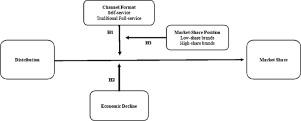Journal of Retailing ( IF 10.0 ) Pub Date : 2021-06-14 , DOI: 10.1016/j.jretai.2021.05.002 Leandro Angotti Guissoni , Jonny Mateus Rodrigues , Felipe Zambaldi , Marcos Fava Neves

|
Retail distribution is one of the major challenges in emerging economies. These economies are volatile and filled with inefficiencies, and the representativeness of unstructured retail increases the complexity of distribution systems for consumer packaged-goods companies.
We analyze 644 brands to extend the existing literature by modeling the retail distribution and market share in an emerging market according to the type of retail channel (full- and self-service channels), moderated by economic fluctuations and the market position of a brand (high- and low-share brands). Our model controls for endogeneity using instrumental variables (IVs) and accommodates heterogeneity across brands and categories by means of a fixed-effects robust regression. Our study highlights that the relationship between distribution and market share exhibits greater convexity in the self-service channel than in the full-service channel. Further, we contribute to the existing research in distribution effectiveness in emerging markets by showing the convex effect of distribution on market share could vary when the economy changes. Distribution gains are more effective in the self-service channel than in the full-service channel in times of economic decline. Also, the results indicate the higher degree of convexity in the relationship between distribution and market share for the self-service channel compared with the full-service channel is increased further for high-share brands than for low-share brands.
中文翻译:

新兴市场经济波动下全渠道和自助渠道的分销效率
零售分销是新兴经济体的主要挑战之一。这些经济体不稳定且效率低下,非结构化零售的代表性增加了消费品公司分销系统的复杂性。
我们分析了 644 个品牌以扩展现有文献,根据零售渠道类型(全方位和自助服务渠道)、经济波动和品牌的市场地位对新兴市场的零售分布和市场份额进行建模(高和低份额品牌)。我们的模型使用工具变量 (IV) 控制内生性,并通过固定效应稳健回归来适应品牌和类别之间的异质性。我们的研究强调,分销和市场份额之间的关系在自助渠道中比在全方位服务渠道中表现出更大的凸性。此外,我们通过展示分销对市场份额的凸性影响可能会随着经济变化而变化,从而为新兴市场分销有效性的现有研究做出贡献。在经济衰退时期,自助服务渠道的分销收益比全方位服务渠道更有效。此外,结果表明,与全服务渠道相比,自助渠道的分销与市场份额之间的关系具有更高的凸度,高份额品牌比低份额品牌进一步增加。



























 京公网安备 11010802027423号
京公网安备 11010802027423号